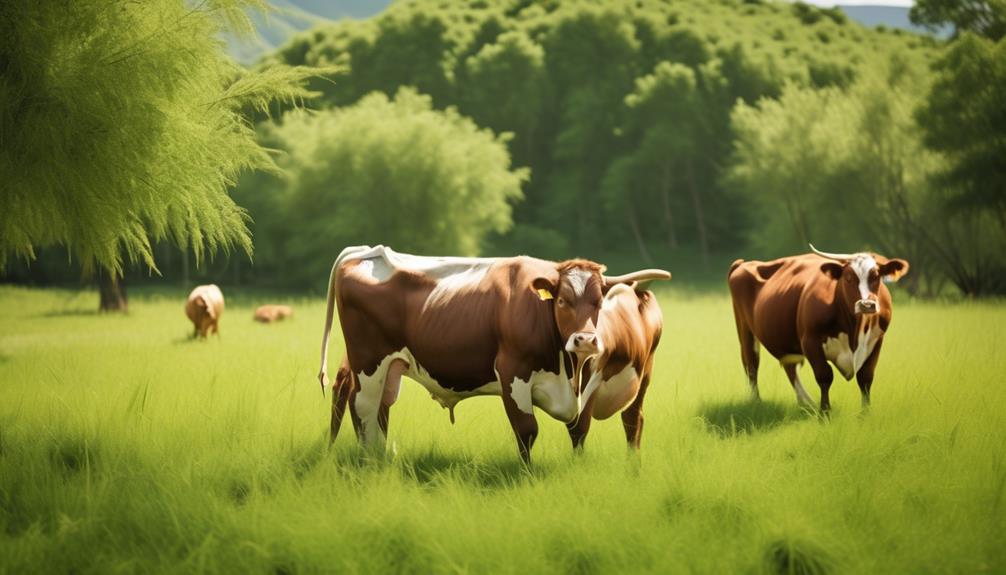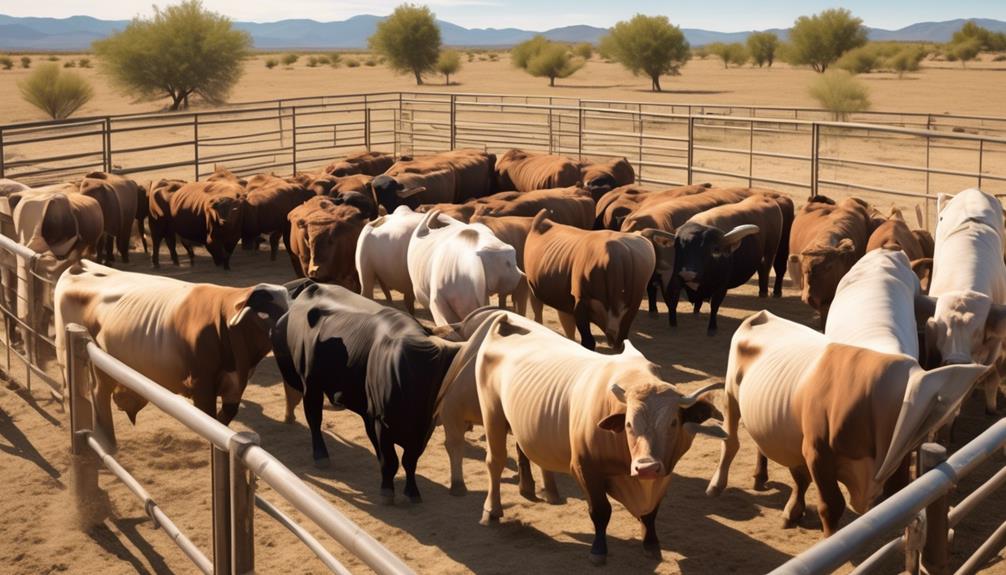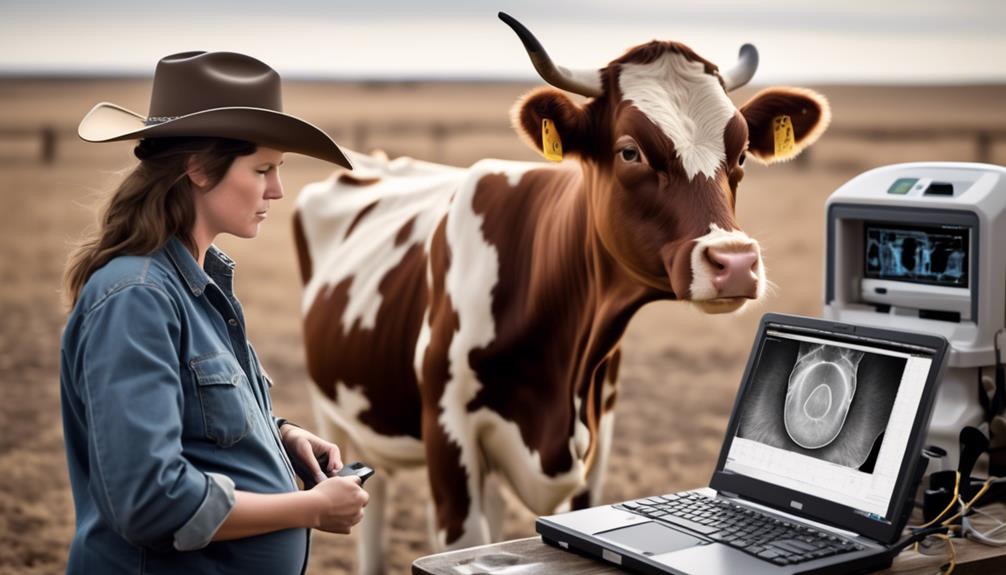Top 10 Tips for Successful Cattle Reproduction
Want to optimize your cattle reproduction efforts without overcomplicating things? It's a common desire, wanting to achieve successful breeding without getting bogged down in unnecessary details. You probably already know that efficient reproduction is crucial for the profitability of your cattle operation.
But where do you start? Well, there are key strategies and techniques that, when carefully implemented, can make a significant difference in your herd's reproductive performance. From nutrition to breeding soundness evaluation and everything in between, these top 10 tips cover the essential aspects of successful cattle reproduction.
So, if you're ready to take your herd's fertility to the next level, stick around to uncover the expert insights that could make all the difference.
Proper Nutrition for Reproduction

For optimal reproductive health in cattle, it's crucial to consistently provide a well-balanced diet rich in essential nutrients and minerals. Nutrition management plays a pivotal role in ensuring fertility health in your cattle. A diet tailored to meet the specific nutritional needs of your herd is essential for successful reproduction.
To begin with, ensure that your cattle have access to high-quality forage and a balanced concentrate feed. This will provide the necessary energy, protein, vitamins, and minerals essential for reproductive function. Proper nutrition is vital for maintaining body condition scores, which directly impact fertility. Cattle that are either too fat or too thin may experience reproductive challenges, so monitoring their body condition and adjusting their diet accordingly is crucial.
In addition, make sure that your cattle have access to clean, fresh water at all times. Water is essential for nutrient absorption and overall health. Proper hydration is especially critical during periods of heat stress, as it can significantly impact reproductive performance.
Furthermore, consider conducting regular forage and feed analysis to ensure that your cattle's diet meets their nutritional requirements. This will help identify any deficiencies and allow you to adjust their diet or provide supplements as needed, thereby supporting their reproductive health.
Breeding Soundness Evaluation
Conduct a thorough breeding soundness evaluation to assess the reproductive capabilities of your cattle before breeding. This evaluation is crucial for ensuring the reproductive efficiency of your herd. Fertility testing is a key component of the evaluation, involving a comprehensive assessment of both male and female cattle.
For bulls, the evaluation includes physical examinations to check for any structural abnormalities that may hinder breeding ability. Additionally, semen analysis is conducted to assess sperm quality and quantity. This analysis helps determine the bull's fertility and the likelihood of successful breeding. Ensuring that your bulls are reproductively sound is essential for achieving high pregnancy rates within your herd.
On the other hand, for cows, the breeding soundness evaluation involves assessing their overall reproductive health. This may include pelvic measurements to ensure they can successfully calve, as well as uterine health checks. Fertility testing for cows also involves examining their estrous cycles and determining if they're reproductively capable.
Estrus Detection and Synchronization

To optimize your cattle's reproductive efficiency, mastering estrus detection and synchronization is crucial for achieving high pregnancy rates within your herd.
Estrus detection involves closely observing your cattle for signs of heat, such as restlessness, mounting behavior, mucus discharge, and swollen vulva. It's essential to be vigilant and familiar with the individual behaviors of your cows to accurately identify when they're in estrus.
Additionally, hormonal synchronization can be utilized to coordinate the breeding cycle of your cattle. This involves using hormones to induce estrus in a group of cattle within a specific time frame, allowing for more efficient breeding management.
Implementing estrus detection and hormonal synchronization techniques can greatly improve the reproductive success of your herd. By accurately detecting estrus, you can ensure that your cattle are bred at the optimal time, maximizing the chances of successful conception.
Furthermore, using hormonal synchronization methods can help streamline the breeding process, making it easier to manage a large herd and increasing the likelihood of a higher pregnancy rate.
Managing Reproductive Diseases
Keeping your cattle healthy and productive requires vigilant management of reproductive diseases and their potential impacts on your herd's fertility. Managing reproductive diseases is crucial for preventing infertility and ensuring the overall reproductive health of your cattle.
Here are some essential tips for effectively managing reproductive diseases in your herd:
- Vaccination: Implement a strategic vaccination program to protect your cattle against common reproductive diseases such as brucellosis, leptospirosis, and infectious bovine rhinotracheitis (IBR).
- Biosecurity Measures: Enforce strict biosecurity protocols to prevent the introduction and spread of reproductive diseases within your herd. This includes quarantine procedures for new additions to the herd and controlling access to your farm premises.
- Regular Monitoring: Conduct routine health checks and diagnostic testing to promptly identify any signs of reproductive diseases. Early detection can significantly reduce the impact of these diseases on your herd's fertility.
- Proper Nutrition: Ensure that your cattle receive a well-balanced diet to support their immune system and overall reproductive health. Proper nutrition plays a critical role in preventing reproductive diseases.
- Consultation with a Veterinarian: Establish a strong partnership with a knowledgeable and experienced veterinarian who can provide guidance on disease management, vaccination schedules, and overall reproductive health strategies for your cattle.
Optimal Bull Management

Maximizing the reproductive potential of your herd hinges on effective bull management, ensuring optimal breeding outcomes and overall herd fertility.
Bull fertility is a critical factor in successful cattle reproduction. To optimize bull management, it's essential to assess the overall health and reproductive capacity of your bulls before and during the breeding season. Prior to the breeding season, conduct a thorough examination of each bull to ensure they're in good physical condition and free from any reproductive issues. This includes assessing their body condition, reproductive organ health, and overall soundness.
Additionally, it's crucial to monitor the body condition of your bulls throughout the breeding season to ensure they maintain a healthy weight and are able to effectively mate with cows.
Furthermore, it's important to provide adequate nutrition for your bulls to support their reproductive function. During the breeding season, bulls have increased energy requirements due to mating activities, so it's essential to adjust their diet accordingly. Ensuring that your bulls receive a balanced diet with the necessary nutrients will contribute to their overall health and reproductive performance.
Additionally, providing proper housing and minimizing stressors can also positively impact bull fertility.
Artificial Insemination Techniques
Implementing artificial insemination techniques can offer a controlled and efficient method for breeding your cattle. By utilizing advanced reproductive technologies, you can improve the genetic potential of your herd and achieve your breeding goals more effectively.
Here are some key techniques to consider:
- Semen Handling and Storage: Proper handling and storage of semen are crucial for maintaining its viability. Using liquid nitrogen tanks for semen storage at ultra-low temperatures ensures its longevity and quality.
- Hormonal Manipulation: Hormonal manipulation can be used to synchronize the estrous cycles of female cattle, allowing for more precise timing of artificial insemination. This technique can enhance the success rate of conception and optimize breeding efficiency.
- Semen Thawing Process: The process of thawing semen requires careful attention to detail. Ensuring a gradual and controlled thawing process is essential for preserving the viability of the spermatozoa.
- Insemination Technique: Employing proper insemination techniques, such as depositing the semen in the correct location within the reproductive tract, is critical for achieving successful fertilization.
- Post-insemination Management: After insemination, monitoring the cattle for signs of estrus and implementing appropriate post-insemination management practices are essential for maximizing conception rates.
Pregnancy Diagnosis and Monitoring

Now that you have implemented artificial insemination techniques, your next step is to ensure accurate pregnancy diagnosis and monitoring to track the progress of your cattle's reproductive health.
Pregnancy diagnosis is crucial in determining the success of the insemination process and allows for timely intervention if needed. One of the most common methods for pregnancy diagnosis is ultrasound. This method not only confirms pregnancy but also provides valuable information about fetal development and the overall health of the pregnancy.
Monitoring reproductive hormones is also essential for successful cattle reproduction. Reproductive hormone levels can indicate the stage of pregnancy and help identify any potential issues. Progesterone, for example, plays a critical role in maintaining pregnancy, so monitoring its levels can provide valuable insights into the pregnancy status.
Regular veterinary check-ups are crucial during this stage. Your veterinarian can conduct thorough examinations and provide guidance on managing the pregnancy. They can also advise on nutrition, vaccination schedules, and any necessary adjustments to ensure the health and well-being of both the cow and the developing calf.
Calving Management and Newborn Care
After confirming the pregnancy, it's crucial to focus on effective management of the calving process and care for the newborn calf. Proper calving management and newborn care are essential for ensuring the health and well-being of the calf and the cow. Here are some important tips to consider:
- Provide a Clean Calving Environment: Ensure that the calving area is clean and dry to reduce the risk of infections for the newborn calf.
- Monitor Newborn Health: Keep a close eye on the newborn calf for signs of good health, such as standing and nursing within the first few hours of birth. Any signs of illness or weakness should be promptly addressed.
- Assist with Difficult Calvings: Be prepared to provide assistance if the cow is having difficulty calving. Timely intervention can prevent injury to both the calf and the cow.
- Ensure Adequate Colostrum Intake: The newborn calf should receive an adequate amount of colostrum, preferably within the first few hours of birth, to acquire essential antibodies for a strong immune system.
- Provide Adequate Nutrition for the Cow: A well-nourished cow is more likely to provide the necessary nutrients for the newborn calf through her milk. Ensure that the cow has access to quality feed and clean water.
Frequently Asked Questions
How Can I Ensure the Best Genetic Diversity in My Cattle Herd for Successful Reproduction?
To ensure the best genetic diversity in your cattle herd for successful reproduction, consider breeding strategies that prioritize genetic selection. Reproductive technology can also help improve genetic diversity by allowing you to introduce new genetics into your herd.
What Are Some Common Environmental Factors That Can Impact Cattle Reproduction and How Can They Be Managed?
Environmental factors such as temperature, humidity, and nutrition can impact cattle reproduction. Manage these by providing proper shelter, ventilation, and balanced diet. Implementing heat stress mitigation techniques and monitoring herd health can help ensure successful reproduction.
Are There Any Alternative Methods for Estrus Detection and Synchronization That Can Be Used Alongside Traditional Methods?
You can enhance cattle reproduction by utilizing alternative methods for estrus detection and synchronization alongside traditional ones. This approach can improve breeding efficiency and overall reproductive success in your herd.
What Are Some Lesser-Known Reproductive Diseases That Can Affect Cattle and How Can They Be Prevented or Managed?
To prevent and manage reproductive diseases in cattle, consider lesser-known illnesses like trichomoniasis and leptospirosis. Implement vaccination programs and biosecurity measures. Monitor genetic diversity and seek veterinary advice. These efforts can enhance breeding success.
What Are Some Advanced Techniques for Artificial Insemination That May Improve Breeding Success Rates?
You can improve breeding success rates with advanced technology in artificial insemination. Reproduction techniques like sexed semen and timed AI can enhance accuracy and efficiency. These methods have been shown to boost conception rates significantly.
Conclusion
So, now that you have the top 10 tips for successful cattle reproduction, it's time to put them into practice.
By focusing on proper nutrition, breeding soundness evaluation, estrus detection, and other key factors, you can improve your herd's reproductive success.
With the right management and techniques, you can ensure healthy pregnancies, successful calving, and ultimately, a thriving cattle operation.
Good luck!
